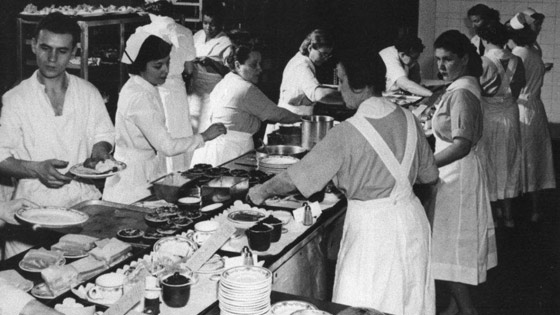
This was one of the kitchens where patient food was cooked at Toronto General Hospital. In the early to mid-1900's, dietitians played a role in the kitchen making and preparing patient food. (Photo: UHN)
Margaret Grapes graduated from the Toronto General Hospital Dietetic internship program in 1949. At the time she felt she was either going to be a teacher or pharmacist, because, in her words, those were the jobs available to women in that era.
When she found out about the dietetic internship, she was excited about doing something different and wrote a letter to Toronto General Hospital to apply.
"I spent most of my time in creating the menu for patients and working in the kitchen," said Grapes. "It was a lot of physical work. I sometimes helped cook or stand in the assembly line to inspect food quality."
Now, a vibrant 87-year-old, Grapes remembers the internship experience fondly.
She stayed in the nursing residence on Gerrard Street and laughed as she remembered the dietetic interns did not have a curfew while the nurses did. She and her colleagues would let the nurses in who were locked out of their rooms after 11 p.m.
Food made from scratch
The dietetic program has evolved to transform the way Canadian dietitians work with patients – from “women working in the kitchen” to dietitians (women and men) working as an integral part of the patient care program.
From 1910 to 1960, Toronto General Hospital had three industrial kitchens, four cafeterias and three dining rooms. Kitchen staff made all the food from scratch for patients and hospital employees.
In the kitchen where patient food was prepared, there was a large conveyer belt from the cooking area to a loading area. Food trays would travel along the belt and workers would stand in an assembly line placing each food item directly onto each tray.
Grapes remembers the care taken to make sure every dish was plated appropriately. In some cases a salad would be topped with a banana rolled in mayonnaise and nuts.
Patients would order every meal from a menu, and the dietitian's role was to make sure the patient received exactly what they selected and offer suggestions based on dietary needs.
"I can still remember stirring the biggest pot of rice pudding I have ever seen," said Grapes. "If kitchen staff was light, we were expected to pitch in whenever we could."
Dietitian role changing
Cathy Robertson was the Dietetic Internship Director from 1974 to 1994 at Toronto General Hospital. During Robertson's time she witnessed a greater need for Clinical Dietitians versus Administrative Dietitians.
"Administrative dietitian's works behind the scenes to make sure patients were served the correct food, the right amount and worked with the kitchen staff and food vendors," said Robertson. "A clinical dietitian works directly with the patient to understand the role that diet plays in their overall treatment."
The role started to change from dietitians being primarily involved with patient's food - to dietitians playing a larger role in patient care and treatment plans, working with all members of the care team.
In the 1990's, Toronto General Hospital also changed the way it served food and no longer cooked from scratch in the kitchen. The food service model was re-designed to provide centralized cold-plating of ready prepared food with re-heating of patient meals in nutrition centres with each one servicing several patient floors.
[Margaret Grapes] laughed as she remembered the dietetic interns did not have a curfew while the nurses did. She and her colleagues would let the nurses in who were locked out of their rooms after 11 p.m.
During this time, the dietetic internship grew to be a highly competitive program.
"We would have the top students come into UHN every year," said Robertson. "And we looked at a number of different factors to determine successful candidates such as interaction with patients, working with staff and experience working in challenging atmospheres."
Today: Food as medicine
Currently, UHN employs 60 Registered Dietitians in Clinical and Food Service Management across all its sites.
The clinical registered dietitian's main role is to collaborate with patients around treatment and promote food as a type of medicine. Clinical Dietitians provide the patient with evidence based and practical nutrition therapy to prevent, treat or manage disease and improve health
"Everyone has a different relationship with food. Part of my job is to help patients understand the impact that food has on their health and wellbeing," said UHN Registered Dietitian, Megan Morrison.
 This is an assembly line where hospital staff prepared each dish for patients. At that time, patients at Toronto General selected their food from a menu. (Photo: UHN)
This is an assembly line where hospital staff prepared each dish for patients. At that time, patients at Toronto General selected their food from a menu. (Photo: UHN)
Celebrating a century
On June 26th, Dietitians at UHN will be celebrating 100 years of the first dietetic internship at Toronto General Hospital.
All graduates for the program are invited and will feature key guest speakers, including:
- Dr. Brian Hodges, CP of Education
- Linda Dietrich, Regional Executive Director of Dietitians of Canada and former UHN Internship Director
- Cathy Robertson, a former UHN Internship Director
- Sharon Zeiler, a 1967 graduate of the Dietetic Internship Program
- Megan Morrison, a 2011 graduate of the Dietetic Internship Program.
Click here to learn more about the event or the role of a dietitian at UHN
